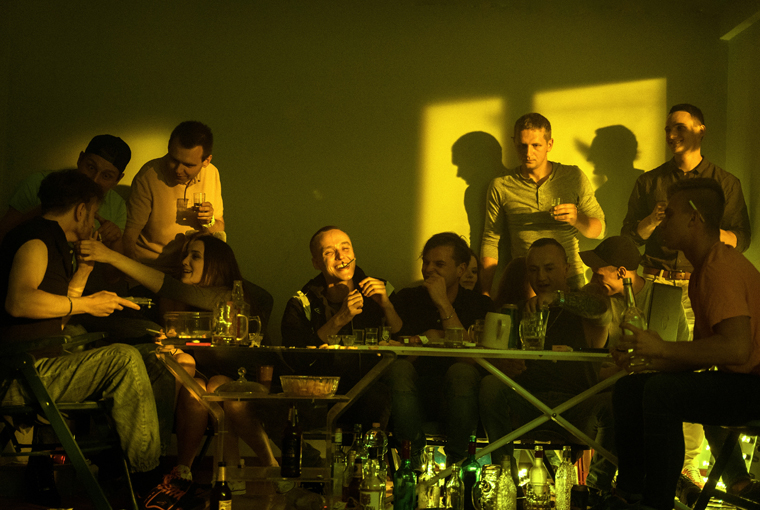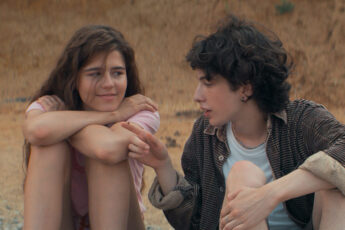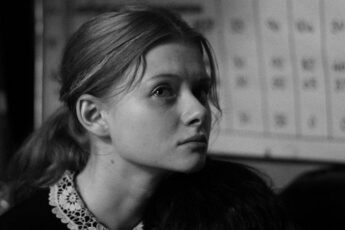Bad Trees Bearing Fruit
Jan Komasa’s Corpus Cristi (Boże Ciało, 2019) & Wojciech Smarzowski’s Clergy (Kler, 2018)
Vol. 104 (April 2020) by Colette de Castro
How does a religion adapt to a changing world? In 2020, Poland remains one of the most devoutly religious countries in Europe; according to the government statistical agency Statistics Poland (stat.gouv.pl), 92.8% of Poles aged 16 years or older identify as Roman Catholic. The two Polish films about priesthood compared in this article, Corpus Cristi (2019) by Jan Komasa, and Clergy (2018) by Wojciech Smarzowski, both bring compelling but totally different answers to the altar. The question of how religion can adapt seems especially significant in the time of Covid-19. Rites and ritual are important in Catholicism, and they often involve touch with its risk of contamination – putting money into the collection basket during mass, sprinkling holy water, and receiving the Eucharist.
As in other religious countries such as India and Iran, in Catholic Poland the virus has exacerbated religious tensions. In March, the Archbishop of Częstochowa described the coronavirus as just “another type of flu”, declaring that wars and “gender ideology” are greater threats to civilization.1 But in other parts of Poland, churches were quickly closed and online mass proved a success, with people attending in droves. The “drive-through confessional” first tried out in Warsaw spread throughout the country and then became a worldwide phenomenon. Parliament has continued to pass unrelated laws and in April conservative party members, under cover of the restrictions of debate, pushed to toughen Poland’s already harsh abortion laws.
“Corpus Cristi” is an ambitious title for a Polish film about a juvenile delinquent who pretends to be a priest. But the director, thirty-eight-year-old Jan Komasa, is nothing if not ambitious. His previous film, Warsaw 44, was a nationalistic and mawkish rampage of a war film released in 2015 to commemorate the Warsaw Uprising of 1944. As I had expected from having seen that film, he has used the audience-appeal of its Hollywood Happy Ending style to his advantage. Corpus Cristi was submitted and then nominated for Best International Feature Film at the 92nd Academy Awards alongside Pedro Almodovar’s Pain and Glory, Ladj Ly’s Les Misérables, Tamara Kotevska and Ljubomir Stefanov’s Honeyland, and of course Bong Joon-ho’s Parasite, which ultimately won.
Corpus Cristi introduces us to Daniel (Bartosz Bielenia), who is serving a sentence in youth-detention for murder. He experiences a kind of spiritual revelation which leads him to beg his carer for permission to study in a seminary. The carer refuses, claiming that a juvenile delinquent would never be accepted into the church. When Daniel departs the next day for a work-camp, he takes a detour past the local church, and steps in to worship. He spies a lone girl and tells her that he is a priest — pulling a home-made clerical collar hesitantly out of his bag. She immediately goes to fetch the priest. Daniel claims to be recently ordained and traveling around local parishes to gain enlightenment and experience. When the priest falls sick the next day, it’s up to Daniel to replace him.
As his upcoming film Hater, also written by young screenwriter Mateusz Pacewicz, testifies, Komasa’s expertise is in portraying the mix of the real and the virtual and in instrumentalizing the way technology fills our daily lives. In one scene, Daniel hastily looks up how to conduct the Sacrament of Penance on his phone as his first penitent begins, “Bless me father…”, his cellphone screen a light in the dark booth. The contrast between old and new traditions is striking. Likewise, the crash of a bus full of teenagers gives him a dramatic nexus, which he cleverly mediates with phone footage. “It’s a story about the claiming of your own identity based on a lie”, the film’s main actor Bartoz Bielenia stated during a Q+A at Toronto Film Festival in 2019. (Wrap your head around that one, Polish film enthusiasts!) Perhaps this sentence wouldn’t be confusing to young people, who spend so much of their time using social media, creating their own identities through a computer screen. In one scene of Corpus Cristi, the main character passionately declares a copy-pasted sermon from the pulpit. Perhaps the lie is not enough to base a whole personality on, but it is enough to get by for the time being.
Mateusz Pacewicz, the screenwriter of Corpus Cristi, refers to the Carpathian foothills as the “bible belt of Europe”. He told Notes from Poland that the phenomenon of copycat priests is not unknown in Poland2:
The phenomenon turned out to be more prevalent than even the film-makers themselves expected. Most of Corpus Christi was shot in a remote village in the Carpathian foothills, where the crew soon began to feel that locals were a little cagey when the film’s topic was broached. It was only when the shoot was over that they discovered that the village had its very own history of a bogus priest. The impersonator had gotten away with it for two years before being rumbled.
These are the stories that should be told. I’m longing to know what the psychological motivations of these “copycat” priests are. Are they attracted to the power, or the debauchery of the Priest lifestyle, and has the portrayal of Priests on screen influenced this phenomenon? The film’s screenwriter claims to have chosen to make his story into a “highly universal one”, because he fears that telling one copycat’s story will bring him legal problems, or indeed glorify him. But I think that telling a true story about why a young person would want to be part of such an antiquated system would do a lot more to shed light on the appeal of the church, how it can adapt to today’s world, than a universal tale combined with different stories possibly can.
Corpus Cristi carries out a fairly smooth and non-confrontational form of criticism of the church. While Komasa’s film was not welcomed by the local priest where it was shot, who did not allow them to use the church in the village, Wojciech Smarzowski’s Clergy was roundly criticized by the Polish clergy, who described it as “vulgar clergyophilia”. Like François Ozon’s By the Grace of God (also released in 2018), the film portrays the Catholic Church as a very powerful body which exists outside the law, with its own system of justice and ways of dealing with corruption. For the viewer, the constant occurrence of bribery is eye-opening. Unlike Ozon’s film however, Clergy is a story of misery from beginning to end; there is no levity in this dark tale.
Whiffs of all the sins — lust, gluttony, greed, sloth, wrath, envy and pride — can be recognized in the three priests the story of Smarzowski’s film is based around. We can literally trace their manifestations. Kukula (Arkadiusz Jakubik) is an alcoholic pedophile, Trybus (Robert Wieckiewicz) is a sociopath and alcoholic, and Lisowski (Jacek Braciak) is having an adulterous relationship with a young woman who comes to be his housekeeper (played by the astonishingly versatile actress Joanna Kulig). The three men drink, run laps to do vodka shots around the house, each seemingly being on the verge of a heart attack. And all three constantly take bribes for everything they do. (This gets slightly laborious – do we really have to see the poor farmer painstakingly giving away his last złoty to the corrupt priest for the twelfth time?)
The event that brings the three priests together in the first scene is a little vague. They toast “to our miraculous rescue” before an image on a computer screen which suggests they were saved from a church which had been set on fire. But this first scene does set up the ominous atmosphere. DoP Tomasz Madejski uses chiaroscuro with a deft hand. A young couple is lit softly; the priest is cut out against black. There is the Light of God, unevenly distributed. These bold contrasts affect the composition throughout the film, making us consider the character’s inner struggles.
Clergy deals with pedophilia with a discerning hand, subtly showing the way that abuse is perpetuated across and down through the generations. This theme takes a larger and larger place in the film as we approach the denouement. Victims’ testimonies pop up rather disconcertingly in the transitions from scene to scene. On top of this, two of the three priests start having flashbacks after questions arise at a press conference. This build-up leads to the very dramatic ending of the film, as there is no way out of the cycle of violence for Kukula.
Though the film’s release dates are only one year apart, their fates have been rather different. While Clergy was a huge success in Poland, it got relatively little international exposure and has not been to many film festivals. Corpus Cristi, on the other hand, was nominated for an Oscar. But there is also a surprising number of similarities between the two films. They both feature confessions, though admittedly their tone is again widely dissimilar: while Daniel shows earnest enthusiasm, Priest Kukula’s confessional scenes involve him either sleeping, or offering uncomfortable advice. He says to a woman whose husband beats her, “First seek fault in yourself.”
Like Komasa, Smarzowski uses different camera techniques, proving he is up-to-date with how young people do reportage. At one point, the camera seems to suddenly switch from professional film aesthetics to a cheap camera phone. When one of the priests is arrested, the wobbly handheld phone aesthetic is documentary-like. It’s kind of a cheap trick but it works so well here that we cannot reproach the filmmakers for using it. In both films the effect is to remind us of the based on a true story origins of the scripts, and not to take the addressed themes lightly. The repulsively true-to-life details of the actor’s bodies on screen are similarly pervasive in both films. Stylish use of close-ups allows us to experience the most gritty details. The flop sweat on the face of the priest giving a sermon in the morning is doubly mirrored on his drunken visage at night. We see how he drinks himself into oblivion while female assistants quietly mop it all up and pray for better days ahead. But while Clergy tries to explore the reasons behind this putrid unraveling, Corpus Cristi takes a lighter and more hopeful approach.
Smarzowski’s work, which is rooted in years of filmmaking, advances a profound questioning of the role of the Church in modern society, whereas Komasa’s expansive film unravels a briefly fleshed out tale of Christian morality. When it comes to battles with one’s own soul, Komasa barely grazes the surface. But his boisterous, happy-go-lucky story seems to say that a renewal of old traditions is possible. Perhaps by opening up the church and being less conservative, the clergy can brush off the dust that has accumulated since the fall of the Berlin wall and start anew. Smarzowski’s objective is a lot less upbeat. His only suggestion, landing heavily at the ending to the film: burn it all to the ground. Clergy quotes Matthew 7:15-20, in its opening seconds; “Watch out for false prophets. They come to you in sheep’s clothing, but inwardly they are ferocious wolves.” I had to look up what comes next, but those who grew up Catholic might know the lines that follow this memorable verse. Matthew continues: “By their fruit you will recognize them. Do people pick grapes from thorn bushes, or figs from thistles? Likewise, every good tree bears good fruit, but a bad tree bears bad fruit.” Priest Kukula considers himself a bad fruit, and sees no other alternative to ending perpetuated abuse of power than cutting the tree at the root.
While Komasa fondly reminisces about Marxists hiding out in churches and having intellectual discussions with priests during the Communist era,3 Smarzowski remembers cycles of abuse over decades, hidden away from the light by greedy and jealous men again and again. How, then, do religions adapt? It is people that adapt, and it is through them that religion can adapt to modern times. The politics of social change might be informed by the wisdom of the past, but altar-sweeping is always necessary, even on the darkest of days.
References
- 1.`Archbishop tells faithful not to fear coronavirus: “Satan is powerless in the face of holy water’’’, March 16, 2020, https://notesfrompoland.com/2020/03/16/archbishop-tells-faithful-not-to-fear-coronavirus-satan-is-powerless-in-the-face-of-holy-water/ [Acceessed on May 13th 2020].
- 2.`How Poland’s phoney village priests inspired two filmmakers to an Oscar nomination,’ Feb 3, 2020, https://notesfrompoland.com/2020/02/03/how-polands-phoney-village-priests-inspired-two-filmmakers-to-an-oscar-nomination/ [Acceessed on May 13th 2020].
- 3.`Q +A on Corpus Cristi’, TIFF, 2019: https://www.youtube.com/watch?v=4pzvNClRgeM [Acceessed on May 13th 2020].




Leave a Comment